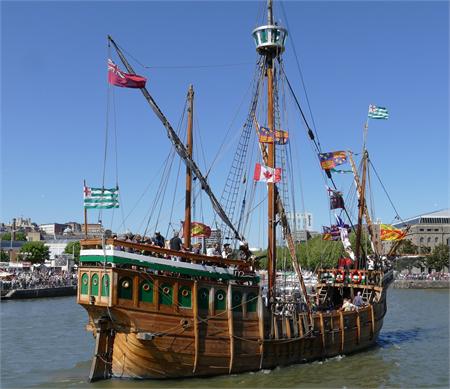Servicing 500-year-old technology is not your usual hydraulics job. In Bristol, however, the local Pirtek franchise has been refitting a caravel, albeit a replica, that dates from the Tudor age.
The Matthew of Bristol was a small ship of 50 tuns burden (able to carry 50 tonnes of cargo). The vessel, of Portuguese caravel design, is thought to have been a regular merchant ship before having been hired for a voyage of exploration.
John Cabot sailed the original Matthew from Bristol to Newfoundland in 1497, just five years after Columbus “discovered” America, or more accurately, the Caribbean. Departing Bristol in early May of that year, she made landfall in North America on 24 June before returning to England in August.
Her ultimate fate is uncertain and little is known about her technical specification other than what can be inferred from images of her and the description in a contemporary letter of “a ship of 50 tuns and 20 men and food for seven or eight months.”
The modern Matthew was built between 1994 and 1996 to celebrate the 500th anniversary of Cabot’s original voyage and she is owned by a charitable trust staffed by volunteers, including some old sea dogs of the Royal Navy. She was reverse engineered from sparse contemporary descriptions, simple illustrations of the ship’s exterior and some theoretical calculations.
The ship is a square rigger, meaning she needs the wind directly behind her so, unlike her predecessor, she has a Caterpillar diesel engine powering a hydraulic pump and motor that allows her to easily manoeuvre inland waters as well as avoid being becalmed at sea.
Engineer on The Matthew, Steve Morgan explains, “For modern sailing regulations we have to have an engine just to get in and out of harbour, but when we’re out in the open ocean we can put the sails up, turn the engine off and do it the old- school, proper way.”
For its maiden voyage, The Matthew replicated John Cabot’s original journey, proving beyond doubt that it was possible in a medieval caravel. Like her predecessor, she took five weeks to sail west, taking on the prevailing winds and zig-zagging across the Atlantic. Returning home was a much easier feat, taking just 17 days.
The Matthew of Bristol Trust took on the vessel in 2013. “The furthest we’ve been in the six years we’ve had her was Vannes in France for a festival of sea,” Steve says. “It took a week to get there.
“When we were coming back, we got caught in a force 11 gale. The ship was rolling right over, the crests of the waves were higher than the main mast, we were just going up and down and rolling over. But she came back every time and we just rode it out for about 12 hours. So that proved the capability of the vessel even in a force 11.”
Formerly a Royal Navy seaman, Steve says, “This is a sailing ship whereas in the navy I was on destroyers. The systems we’ve got here are just like you get on a warship. The warship’s just bigger and more complicated. We have fuel, engine, driveshafts, gas cooking, domestics, hot water, electric. It’s exactly the same, just on a much smaller and simpler scale.
“She doesn’t go fast obviously because she’s short and fat. I understand they’ve had up to 12 knots under full sail but we normally plod around at about five or six knots, which is a nice leisurely pace.”
Berthed outside the Bristol MShed museum, the vessel is free to look around and available for hire. Packages available include one to two hour fish and chip or cream tea trips for up to 40 people, longer three to four hour Avon Gorge trips and educational tours for school children around the harbour. The Matthew can also be hired for corporate hospitality and team building events.
The modern Matthew sailed from Bristol to Newfoundland in May 1997, making landfall in Bonavista and she has subsequently enjoyed may voyages and appeared in film and television.
“We’re licensed for 40 people,” Steve says. “That’s the maximum we can take in the harbour. Then when we go out to sea, we’re licensed for 12.”
Pirtek’s work on The Matthew related to both the annual Maritime and Coastguard Agency certification and longer-term maintenance of the 20-year-old vessel. This long-term service of the entire vessel and all its systems and structures has been expensive at £25-£30,000 but is absolutely necessary.
Skipper Rick Wakeham says, “We’ve done some rigging, we’ve done some planks, some electrical work, all the systems on the ship, we have to go over it, make sure all this life saving equipment is in date. Our maintenance period started on the first of December and it will finish in the second week of March.”
Steve says, “As with anything wooden it requires constant maintenance and one of the major parts was what we called Pirtek in to do, the hydraulic system. Over the last six years we’ve worked our way through the boat replacing, updating it and hydraulics was the one of the last big jobs to be done.
“We called Pirtek and they’ve done an excellent job. In three days, they’ve gone from stem to stern and replaced every hydraulic flexible hose and a few others on top of that, to give us confidence in the boat.”
“We’ve used Pirtek for bits and pieces for years,” says Rick. “They’ve always been helpful and knowledgeable so it seemed natural to me to ask them to take this job on.”
Pirtek Bristol MSST, Chay Cotton says, “Essentially, it’s just normal hydraulic pipes. But access on ships is a bit restricted so it’s harder than everyday machinery. Some of the hoses have been on the ship for about 20 years, so just getting some of them undone was an issue.
“It’s like any job, you get some easy ones, some harder ones. This is the first ship that I’ve worked on, it’s something different and that’s a good thing.”
Steve says, “We’ve gone for the best possible hoses that Pirtek recommended. When we go to sea or even up or down the harbour, when you’ve got a boat full of schoolchildren, you have to have complete confidence in the engine and the hydraulics.
“If we got a burst hose at sea, we would lose all propulsion. Then we would be at the mercy of the wind and the tide, which isn’t good.
“On boats, hydraulics are compact, buried under decks and inaccessible. Even if it were possible to fix it at sea, we would have to find the problem first. We’ve had to remove the galley, sinks to get to the original hoses.
“Now we have that confidence and she should be good for at least another 20 years.” https://matthew.co.uk






Select a country